 W
WThe Atlantic Veterinary College (AVC) is an accredited and globally recognized veterinary school in the Faculty of Veterinary Medicine at University of Prince Edward Island, located in Charlottetown, Prince Edward Island, Canada.
 W
WAn avian veterinarian is a veterinarian who specializes in treating birds. All veterinarians, upon first qualification from a certified veterinary college, may treat any species. Additional training is required for qualification to become a recognized specialist in the care of birds.
 W
WBetacoronavirus 1 is a species of coronavirus which infects humans and cattle. The infecting virus is an enveloped, positive-sense, single-stranded RNA virus and is a member of the genus Betacoronavirus and subgenus Embecovirus. It has, like other embecoviruses, an additional shorter spike-like surface protein called hemagglutinin esterase (HE).
 W
WBoehringer Ingelheim Animal Health is a multinational animal health company, formed in January 2017 when Merial was acquired by Boehringer Ingelheim and merged with Boehringer Ingelheim's existing animal health assets.
 W
WBrachygnathism or colloquially parrot mouth, is the uneven alignment of the upper and lower teeth in animals. In serious cases, the upper teeth protrude beyond the lower teeth. Problem with parrot mouth occur if the molars at the back of the mouth are also uneven, resulting in large hooks forming on the upper molars and the rear of the lower back molars. Horses with parrot mouth often require dental treatment at least every six months to remove the hooks and maintain alignment.
 W
WIn animal breeding, a breeding mount or phantom mount is an imitation of a female animal used to hold an artificial vagina for collecting semen from a male animal for use in artificial insemination. In use, the male animal is encouraged to mount the breeding mount as if he were copulating with a female. Breeding mounts are commonly used in conjunction with a real female of the same species nearby, to bring the male to full sexual arousal so that he is ready to mount the breeding mount. In the case of horses, this is known as the "tease mare".
 W
WThe Burdizzo is a castration device which employs a large clamp designed to break the blood vessels leading into the testicles. Once the blood supply to the testicles is lost, testicular necrosis occurs, and the testicles shrink, soften, and eventually deteriorate completely. When the device is used, the operator crushes the spermatic cords one at a time, leaving a space in between in order to prevent an interruption of blood-flow to the scrotum.
 W
WCardiovirus A is a member of the Picornaviridae family. Infection with the virus causes encephalomyocarditis and reproductive disease in pigs. Although a variety of mammals may host the virus, pigs are classed as the domestic host as they are most easily infected. It is thought to be spread by rodents.
 W
WCervical dislocation is a common method of animal euthanasia. It refers to a technique used in physical euthanasia of small animals by applying pressure to the neck and dislocating the spinal column from the skull or brain. The aim is to quickly separate the spinal cord from the brain so as to provide the animal with a fast and painless death; however, research on this method has shown it does not consistently concuss the brain and may not cause instantaneous insensibility.
 W
WCimicoxib is a nonsteroidal anti-inflammatory drug (NSAID) used in veterinary medicine to treat dogs for pain and inflammation associated with osteoarthritis and for the management of pain and inflammation associated with surgery. It acts as a COX-2 inhibitor.
 W
WClamoxyquine (INN) or clamoxyquin, as the pamoate or hydrochloride salt, is an antiamebic and antidiarrheal drug.
 W
WCloprostenol is a synthetic analogue of prostoglandin F2α (PGF2α). It is a potent luteolytic agent; this means that, within hours of administration, it causes the corpus luteum to stop production of progesterone, and to reduce in size over several days. This effect is used in animals to induce estrus and to cause abortion.
 W
WCorynebacterium renale is a pathogenic bacterium that causes cystitis and pyelonephritis in cattle.
 W
WSir Thomas Dalling was a Scottish veterinarian and bacteriologist. From 1948 to 1952 he held the office of Chief Veterinary Officer to the United Kingdom.
 W
WAn emasculator is a tool used in the castration of livestock. Its function is to simultaneously crush and cut the spermatic cord, preventing hemorrhaging while still detaching the testis from the animal.
 W
WThe Faculty of Veterinary Medicine, University of León is a veterinary school in Spain. It is part of the University of León, and is situated in the university campus of Vegazana.
 W
WFirocoxib is a nonsteroidal anti-inflammatory drug of the COX-2 inhibitor (coxib) class, currently approved for use in dogs and horses. Firocoxib was the first COX-2 inhibitor approved by the U.S. Food and Drug Administration for horses. Firocoxib is not intended or approved for use in human medicine.
 W
WFish medicine is the study and treatment of the diseases of fish. Although some practitioners work primarily with aquarium fish, this field also has important applications to fisheries management.
 W
WFluralaner (INN) is a systemic insecticide and acaricide that is administered orally. The U.S. Food and Drug Administration (FDA) approved it under the trade name Bravecto for flea treatment in dogs in May 2014. The EU approved the drug in February 2014. Australia approved it for the treatment and prevention of ticks and fleas on dogs in January 2015.
 W
WGasterophilus haemorrhoidalis is a species of the genus Gasterophilus that lays eggs on the lips and around the mouth of horses, mules and donkeys.
 W
WWilliam Llewelyn "Buster" Lloyd-Jones (1914–1980) was a British veterinary practitioner.
 W
WLymphoid leucosis is a disease that affects chickens, caused by the retrovirus Avian leukosis virus.
 W
WMavacoxib is a veterinary drug used to treat pain and inflammation in dogs with degenerative joint disease. It acts as a COX-2 inhibitor.
 W
WProf James McCall FRCVS was the founder and the first principal of Glasgow Veterinary College.
 W
WMitratapide is a veterinary drug for the treatment of overweight and obese dogs sold under the brand name Yarvitan. Its mechanism of action involves inhibition of microsomal triglyceride transfer protein (MTP) which is responsible for the absorption of dietary lipids. Clinical study also suggests that mitratapide may help to reverse insulin resistance in dogs.
 W
WMycoplasma iguanae is a species of bacteria in the genus Mycoplasma. It is classified in the domain Bacteria, phylum Firmicutes, class Mollicutes, order Mycoplasma, and family Mycoplasmataceae.
 W
WOrbifloxacin is a fluoroquinolone antibiotic which is approved for use in dogs, marketed by Schering-Plough Animal Health.
 W
WThe Orthopedic Foundation for Animals (O.F.A.) is a nonprofit organization based in Columbia, Missouri that aims to research and prevent orthopedic and hereditary diseases in companion animals. As a private not-for-profit foundation, the OFA has funded nearly $3 million in research aimed at reducing the incidence and prevalence of inherited companion animal disease. The OFA funds projects through the AKC Canine Health Foundation, the Morris Animal Foundation and occasionally through direct grants. The OFA has achieved Ruby Donor status with MAF, and Millennium Founder status with the AKC CHF. OFA supported research is not limited to orthopedic disease, and has included cancers, heart disease, and thyroid disease as examples. Some research has been breed specific, some for all breeds, some for multiple species, and has been done at many of our leading universities and research institutions. And, with the recent completion of the mapping of the canine genome, the OFA is focusing more of its research dollars towards research at the molecular level.
 W
WOxibendazole is a benzimidazole drug that is used to protect against roundworms, strongyles, threadworms, pinworms and lungworm infestations in horses and some domestic pets. It is usually white to yellowish in appearance, and may take the form of a powder, tablet or paste.
 W
WParasitic bronchitis, also known as hoose, husk, or verminous bronchitis, is a disease of sheep, cattle, goats, and swine caused by the presence of various species of parasite, commonly known as lungworms, in the bronchial tubes or in the lungs. It is marked by cough, dyspnea, anorexia and constipation. Lungworms which cause parasitic bronchitis include nematodes of the genera Dictyocaulus, Metastrongylus, and Protostrongylus. Hoose is essentially an infantile disease, almost always afflicting animals under one year of age.
 W
WPardis Animal Shelter is a no-kill animal shelter, a spay/neuter clinic, and a public animal hospital located near Tabriz, Iran. It is affiliated with "Tabriz Society for the Prevention of Cruelty to Animals" which is a volunteer nonprofit organization based in Tabriz, devoted to pet adoption and animal rescue. Pardis Shelter was founded by Jila Pourirani in 2012, after a massive cull that nearly 400 dogs were shot dead in Tabriz. Pardis Shelter has a clinic, 11 shelters, three niches and shaded areas. 1300 animals of different kinds including dogs, cats, foxes, horses and birds such as eagle, owl and vultures are being treated and sheltered in this center.
 W
WPersistent pupillary membrane (PPM) is a condition of the eye involving remnants of a fetal membrane that persist as strands of tissue crossing the pupil. The pupillary membrane in mammals exists in the fetus as a source of blood supply for the lens. It normally atrophies from the time of birth to the age of four to eight weeks. PPM occurs when this atrophy is incomplete. It generally does not cause any symptoms. The strands can connect to the cornea or lens, but most commonly to other parts of the iris. Attachment to the cornea can cause small corneal opacities, while attachment to the lens can cause small cataracts. Using topical atropine to dilate the pupil may help break down PPMs.
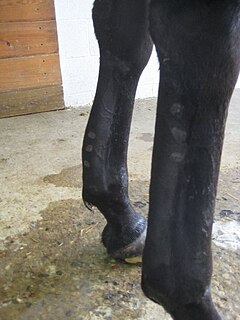 W
WPin firing, also known as thermocautery, is the treatment of an injury to a horse's leg, by burning, freezing, or dousing it with acid or caustic chemicals. This is supposed to induce a counter-irritation and speed and/or improve healing. This treatment is used more often on racehorses than on other performance horses. It is sometimes used in the treatment of bucked shins or splint, curb, or chronic bowed tendons. There was also the theory that it would "toughen" the leg of the horse. This treatment is prevalent in equine veterinary books published in the early 20th century; however many present-day veterinarians and horse owners consider it barbaric and a cruel form of treatment. It is not generally taught in veterinary schools today.
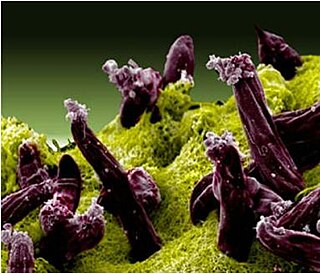 W
WPlasmodium gallinaceum is a species of the genus Plasmodium that causes malaria in poultry.
 W
WPonazuril (INN), sold by Merial, Inc., now part of Boehringer Ingelheim, under the trade name Marquis® , is a drug currently approved for the treatment of equine protozoal myeloencephalitis (EPM) in horses, caused by coccidia Sarcocystis neurona. More recently, veterinarians have been preparing a formulary version of the medication for use in small animals such as cats, dogs, and rabbits against coccidia as an intestinal parasite. Coccidia treatment in small animals is far shorter than treatment for EPM.
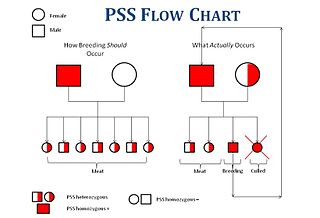 W
WPorcine stress syndrome, also known as malignant hyperthermia or PSS, is a condition in pigs. It is characterised by hyperthermia triggered by stress, anaesthesia with halothane or intense exercise. PSS may appear as sudden death in pigs, often after transport. It is an inherited, autosomal recessive disorder due to a defective ryanodine receptor leading to huge calcium influx, muscle contracture and increase in metabolism.
 W
WRafoxanide is a salicylanilide used as an anthelmintic. It is most commonly used in ruminant animals to treat adult liver flukes of the species Fasciola hepatica and Fasciola gigantica.
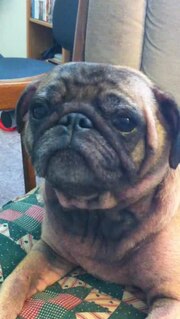 W
WReverse sneezing is a phenomenon observed in dogs, particularly in those with brachycephalic skulls. It is a fairly common respiratory event in dogs, but is rarely seen in cats. Its exact cause is unknown but may be due to nasal, pharyngeal, or sinus irritation, the dog's attempt to remove mucus, or from overexcitement. It is characterized by rapid and repeated forced inhalation through the nose, accompanied by snorting or gagging sounds. Though it may be distressing to the animal, it is not known to be harmful. Most dogs are completely normal before and after episodes, and most will have repeat episodes of reverse sneezing throughout their lives.
 W
WRobenacoxib is a nonsteroidal anti-inflammatory drug (NSAID) used in veterinary medicine for the relief of pain and inflammation in cats and dogs.
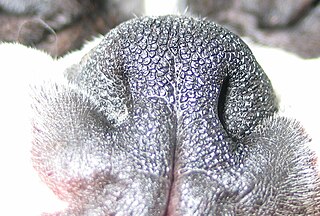 W
WStenotic nares is part of the brachycephalic syndrome of short-nosed dogs. Breeds such as Boxers, Bulldogs, King Charles Spaniels, Pugs, Boston Terriers, Shih Tzus, Lhasa Apsos, etc. are all considered brachycephalic breeds. Stenotic nares means the nostrils are pinched or narrow. This makes it more difficult to breathe and causes snorting and snoring in these animals. It is a congenital trait; these animals are born with it. Veterinarians perform a simple surgery to help widen the nares, often at the same time as a spay or neuter.
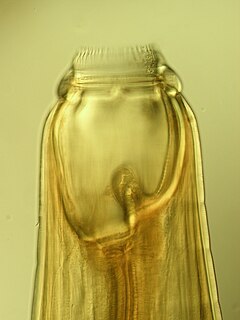 W
WStrongyles, or alternatively, strongyls, are nematode worms of the family Strongylidae, order Strongylida. They are often parasitic in the gastrointestinal tract of mammals, especially grazers such as sheep, cattle and horses.
 W
WSulfaquinoxaline is a veterinary medicine which can be given to cattle and sheep to treat coccidiosis. It is available in Pakistan with Sanna Laboratories in combination with Amprolium and Vitamin K as potential treatment of coccidiosis.
 W
WSynchysis scintillans is a degenerative condition of the eye resulting in liquefied vitreous humor and the accumulation of cholesterol crystals within the vitreous. It is also known as cholesterolosis bulbi. The vitreous liquifies in a process known as syneresis. Synchysis scintillans appears as small white floaters that freely move in the posterior part of the eye, giving a snow globe effect. It is most commonly seen in eyes that have suffered from a degenerative disease and are end-stage.
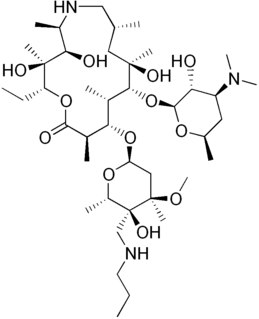 W
WTulathromycin, sold under the brand name Draxxin among others, is a macrolide antibiotic used to treat bovine respiratory disease (BRD) in cattle and swine respiratory disease in pigs.
 W
WUlcerative dermal necrosis (UDN) is a chronic dermatological disease of cold water salmonid fish that had a severe impact on north Atlantic Salmon and sea trout stocks in the late 1960s and 1970s–1980. Despite much investigation, the cause of UDN has not been determined.
 W
WVedaprofen is a nonsteroidal anti-inflammatory drug (NSAID) used in veterinary medicine for the treatment of pain and inflammation due to musculoskeletal disorders in dogs and horses and for the treatment of pain due to horse colic.
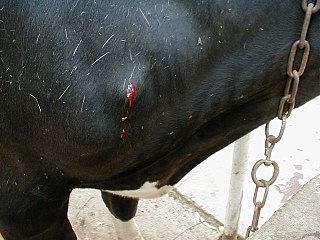 W
WVerminous haemorrhagic dermatitis is a filariasis of cattle marked by a cutaneous haemorrhagic nodule. It is referred sometimes to as "summer wound".
 W
WVeterinary obstetrics are the obstetrical methods used in veterinary medicine, which are quite different from those of human medicine. Veterinary obstetrics is a branch of veterinary medicine that deals with medical and surgical care together with manipulations of the female animals in breeding, gestation, labor, purperium and care of the neonates.
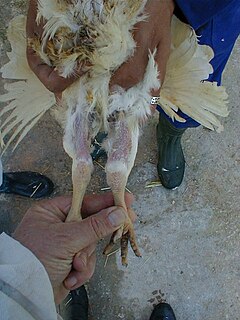 W
WViral arthritis is an infectious condition in chickens and to a lesser extent, turkeys, due to a reovirus.
 W
WXanthochromism is an unusually yellow pigmentation in an animal. It is often associated with the lack of usual red pigmentation and its replacement with yellow. The cause is usually genetic but may also be related to the animal's diet. A Cornell University survey of unusual-looking birds visiting feeders reported that 4% of such birds were described as xanthochromistic. The opposite of xanthochromism, a deficiency in or complete absence of yellow pigment, is known as axanthism.